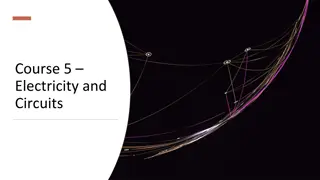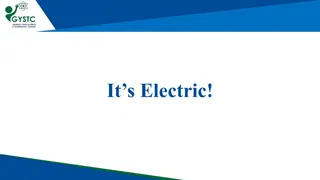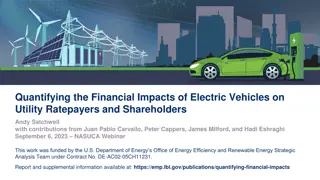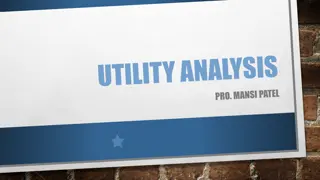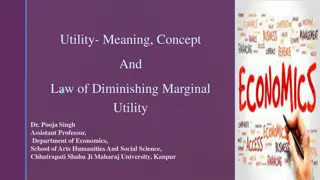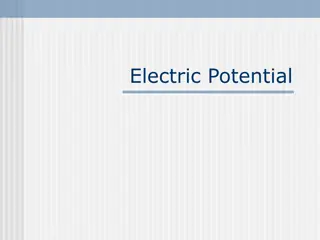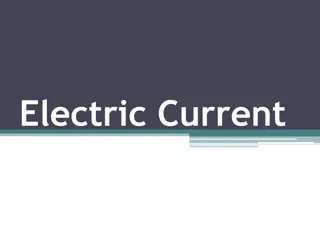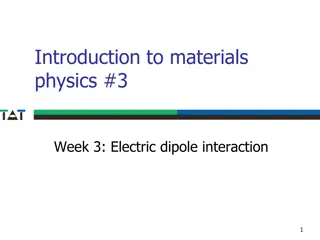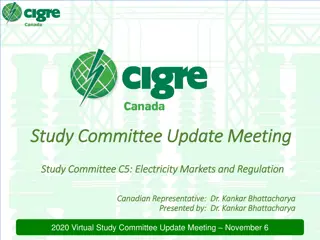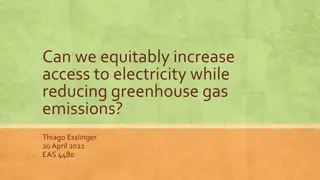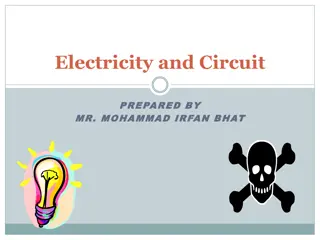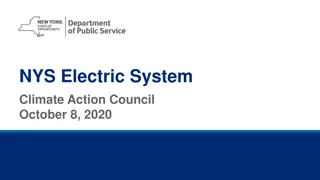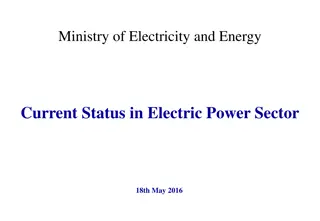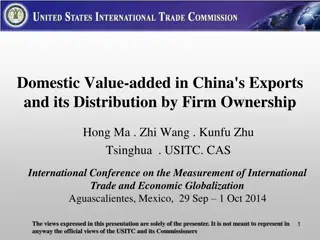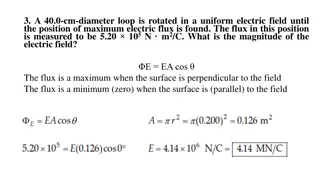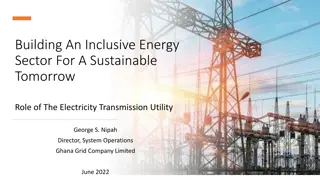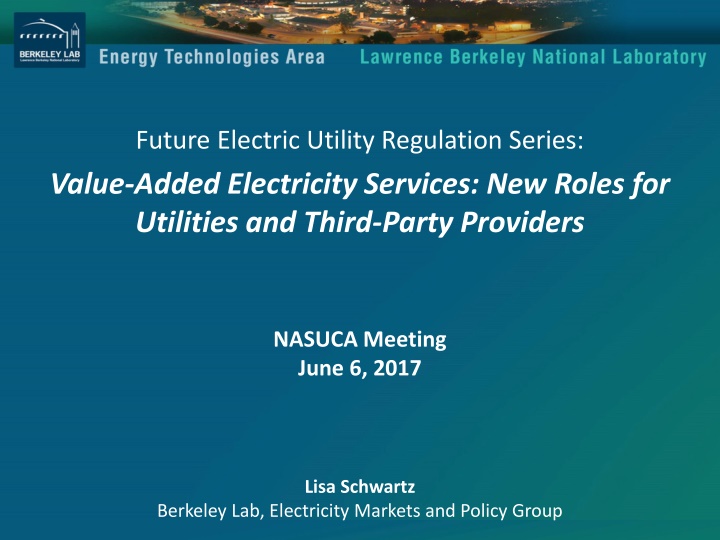
Future Electric Utility Regulation Series: Value-Added Electricity Services
A series of reports from Berkeley Lab discussing complex regulatory issues for electricity, with insights on future utility regulation and business models to achieve a reliable, affordable, and flexible power system. Reports cover various aspects including distributed energy resources, utility fixed costs recovery, and more.
Download Presentation

Please find below an Image/Link to download the presentation.
The content on the website is provided AS IS for your information and personal use only. It may not be sold, licensed, or shared on other websites without obtaining consent from the author. If you encounter any issues during the download, it is possible that the publisher has removed the file from their server.
You are allowed to download the files provided on this website for personal or commercial use, subject to the condition that they are used lawfully. All files are the property of their respective owners.
The content on the website is provided AS IS for your information and personal use only. It may not be sold, licensed, or shared on other websites without obtaining consent from the author.
E N D
Presentation Transcript
Future Electric Utility Regulation Series: Value-Added Electricity Services: New Roles for Utilities and Third-Party Providers Future Electric Utility Regulation Advisory Group Meeting NASUCA Meeting June 6, 2017 March 27, 2014 Lisa Schwartz Berkeley Lab, Electricity Markets and Policy Group
Future Electric Utility Regulation Series A series of reports from Berkeley Lab taps leading thinkers to grapple with complex regulatory issues for electricity Unique multi-perspective approach highlights different views on the future of electric utility regulation and business models and achieving a reliable, affordable, and flexible power system to inform ongoing discussion and debate Primary funder of initial six reports: U.S. Department of Energy s Office of Electricity Delivery and Energy Reliability - Electricity Policy Technical Assistance Program Office of Energy Efficiency and Renewable Energy s Solar Energy Technologies Office is co-funding new reports under DOE s Grid Modernization Initiative Expert advisory group provides guidance and review (see extra slides) feur.lbl.gov 2
Reports published so far 1. Distributed Energy Resources (DERs), Industry Structure and Regulatory Responses 2. Distribution Systems in a High DER Future: Planning, Market Design, Operation and Oversight 3. Performance-Based Regulation in a High DER Future 4. Distribution System Pricing With DERs 5. Recovery of Utility Fixed Costs: Utility, Consumer, Environmental and Economist Perspectives 6. TheFuture of Electricity Resource Planning 7. The Future of Centrally-Organized Wholesale Electricity Markets 8. Regulatory Incentives and Disincentives for Utility Investments in Grid Modernization Reports, webinar slides and recordings at feur.lbl.gov 3
One example: Report #5 Recovery of Utility Fixed Costs: Utility, Consumer, Environmental and Economist Perspectives Utility - Lisa Wood, Institute for Electric Innovation/The Edison Foundation, and Ross Hemphill, RCHemphill Solutions (former ComEd VP) Consumer - John Howat, National Consumer Law Center Environmental - Ralph Cavanagh, Natural Resources Defense Council Economist - Severin Borenstein, University of California, Berkeley 5
Four Perspectives on Fixed Cost Recovery* Wood/Hemphill Howat Formula ratemaking streamlined, enables investments in critical infrastructure Higher fixed charges cost-based, provides transparency in pricing grid services Demand charges cost-based, may incent more EE and DR Time-varying rates Properly designed and optional, some customers can reduce bills Decoupling With consumer protections, enables EE Formula rate plans With performance standards and consumer protections Minimum bills But in most cases won t effectively address fixed cost recovery shortfall Favored approaches and why Decoupling and LRAM Work well for EE, but too much cost- shifting with high levels of distributed solar Minimum bills Level of minimum bill unlikely to recover full cost of grid services Higher fixed charges Shifts costs from high- to low-volume customers (low-income & elder), reduces EE incentives & control over bills Demand charges Consumers lack ability to respond LRAM Incentive for utility to overstate savings and weaken EE program effectiveness Least favored approaches and why *See footnotes on prior slide & report at feur.lbl.gov 6
Environmental and Economist Views* Cavanagh Favored approaches and why contribution to maintaining critical infrastructure Time-varying rates Economically efficient, support EE & distributed resources Decoupling Necessary but not sufficient to recover fixed costs & enable EE Formula rate plans Facilitates recovery of escalating multi-year costs of grid upgrades, use with decoupling Demand charges Works with EE & solar, link to system-wide peak Higher fixed charges Reduce customers incentive for EE and distributed resources LRAM Creates incentive for utility to promote EE programs with little savings, incentive to increase energy sales remains Borenstein Minimum bills Ensure that all customers make a reasonable Time-varying rates Should reflect full social marginal cost (SMC), with remaining revenue from higher volumetric rates and higher fixed charges Higher fixed charges Use with time-varying rates (see above). Concerns remain re: large vs. small users and low-income households. Claim that Fixed costs should be recovered with fixed charges has no basis in economics. Minimum bills identical to fixed charge plus free electricity, not cost-based Demand charges inefficient, more volatile than dynamic pricing, not cost-based Others Don t fix problem Least favored approaches and why 7
Another example: The Future of Centrally-Organized Wholesale Electricity Markets Four perspectives: Craig Glazer, PJM Jay Morrison and Paul Breakman, National Rural Electric Cooperative Association Allison Clements, Natural Resources Defense Council National Association of State Utility Consumer Advocates Four questions: 1. Are today s centrally-organized market designs adequate to accommodate state public policy goals, and what potential design changes would further enable deployment of resources that achieve the goals of reliability, affordability and resource mix? 2. What are the market impacts of environmental regulations further constraining the deployment of fossil fuel resources? 3. What are the market impacts of integrating increasingly higher levels of renewable resources with zero marginal cost? 4. Are today s market designs adequate to acquire the flexible resources needed to better integrate increasing levels of variable energy resources at least cost? 9
New Report: Value-Added Electricity Services: New Roles for Utilities and Third-Party Providers (1) Questions report will address What new value-added services does grid modernization enable, and what are the appropriate roles for utilities and third-party service providers? Should utilities directly compete with competitive providers of new value-added services, or provide new platforms and procurement mechanisms to enable third-party services? What policy and regulatory changes may be needed in the face of increasing competition for electricity services from third-party providers? How should regulators address utility costs for new value-added services, considering customers who do not participate in these offerings? What policy and regulatory approaches best balance promoting innovation with consumer protection? 9
New Report: Value-Added Electricity Services: New Roles for Utilities and Third-Party Providers (2) Perspectives Consumers: National Association of State Utility Consumer Advocates Utilities: Jon Blansfield and Lisa Wood, Institute for Electric Innovation Third-party providers: Ryan Katofsky, Advanced Energy Economy Timeline June - Draft perspectives due to Berkeley Lab July Revisions by authors and presentation at NARUC meeting (July 17) August Review by Advisory Group and DOE September Final report published, public webinar 10
For More Information Lisa Schwartz Electricity Markets and Policy Group Lawrence Berkeley National Laboratory (510) 486-6315 lcschwartz@lbl.gov Join Berkeley Lab s Electricity Markets and Policy Group mailing list (https://emp.lbl.gov/mailing-list) and stay up to date on our publications, webinars and other events. Follow the Electricity Markets & Policy Group on Twitter @BerkeleyLabEMP 11
Future Electric Utility Regulation Advisory Group Commissioner Lorraine Akiba, Hawaii Public Utilities Commission Janice Beecher, Institute of Public Utilities, Michigan State University Doug Benevento, Xcel Energy Ashley Brown, Harvard Electricity Policy Group Paula Carmody, Maryland Office of People s Counsel Ralph Cavanagh, Natural Resources Defense Council Steve Corneli, consultant Tim Duff, Duke Energy Peter Fox-Penner, Boston University Questrom School of Business Scott Hempling, attorney Val Jensen, Commonwealth Edison Commissioner Travis Kavulla, Montana Public Service Commission Steve Kihm, Seventhwave Chair Nancy Lange, Minnesota Public Utilities Commission Lori Lybolt, Consolidated Edison Sergej Mahnovski, Edison International Kris Mayes, Arizona State University College of Law/Utility of the Future Center Jay Morrison, National Rural Electric Cooperative Association Delia Patterson, American Public Power Association Commissioner Carla Peterman, California Public Utilities Commission Sonny Popowsky, Former consumer advocate of Pennsylvania Karl R bago, Pace Energy & Climate Center, Pace University School of Law Rich Sedano, Regulatory Assistance Project Peter Zschokke, National Grid 12

